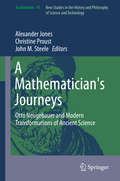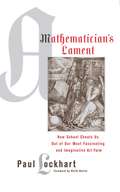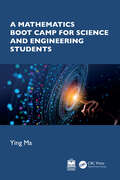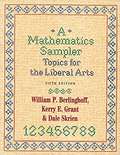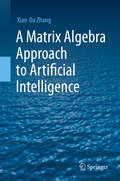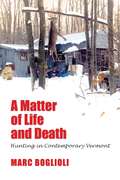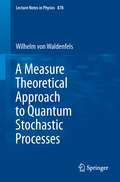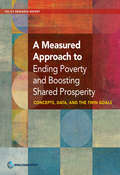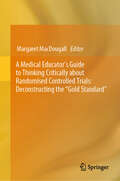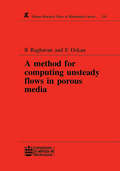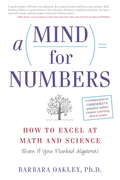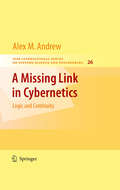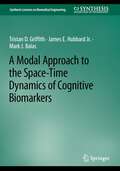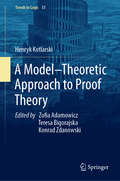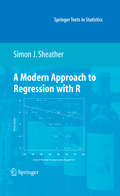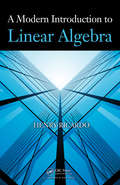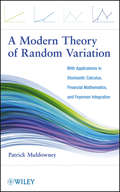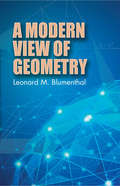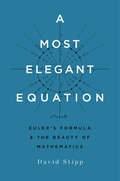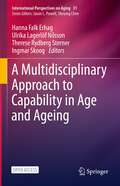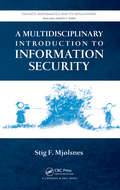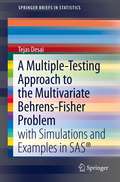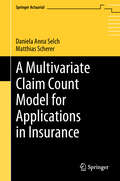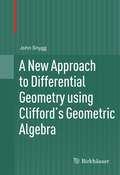- Table View
- List View
A Mathematician's Journeys: Otto Neugebauer and Modern Transformations of Ancient Science (Archimedes #45)
by Alexander Jones John M. Steele Christine ProustThis book explores facets of Otto Neugebauer's career, his impact on the history and practice of mathematics, and the ways in which his legacy has been preserved or transformed in recent decades, looking ahead to the directions in which the study of the history of science will head in the twenty-first century. Neugebauer, more than any other scholar of recent times, shaped the way we perceive premodern science. Through his scholarship and influence on students and collaborators, he inculcated both an approach to historical research on ancient and medieval mathematics and astronomy through precise mathematical and philological study of texts, and a vision of these sciences as systems of knowledge and method that spread outward from the ancient Near Eastern civilizations, crossing cultural boundaries and circulating over a tremendous geographical expanse of the Old World from the Atlantic to India.
A Mathematician's Lament
by Paul Lockhart Keith Devlin"One of the best critiques of current mathematics education I have ever seen."--Keith Devlin, math columnist on NPR's Morning EditionA brilliant research mathematician who has devoted his career to teaching kids reveals math to be creative and beautiful and rejects standard anxiety-producing teaching methods. Witty and accessible, Paul Lockhart's controversial approach will provoke spirited debate among educators and parents alike and it will alter the way we think about math forever.Paul Lockhart, has taught mathematics at Brown University and UC Santa Cruz. Since 2000, he has dedicated himself to K-12 level students at St. Ann's School in Brooklyn, New York.
A Mathematics Boot Camp for Science and Engineering Students
by Ying MaMany students have difficulty applying mathematical techniques to solve problems in science and engineering, even after completing Calculus I and II. Students who are beginning the core coursework in their field of study often need additional guidance on practicing, learning, and improving their problem-solving skills for application. The objectives of A Mathematics Boot Camp for Science and Engineering Students are to offer a solution to this issue and are specifically designed to address common errors in mathematical problem-solving for undergraduate science and engineering students. Teaches readers how to apply math skills as they transition to coursework in their chosen field of study Includes strategies and recommendations for quick improvement in problem-solving skills Emphasizes the physical meanings of the problem, which helps students develop a deep understanding of their field of study Features a broad range of example problems with detailed and easy-to-follow solutions for students to learn problem-solving techniques and additional exercise problems for further practice and improvement Bridges the gap between the knowledge of mathematical techniques and the ability to apply those techniques to solve real-world problems This concise and practical text offers "basic training" in mathematical problem-solving skills for undergraduate students in science and engineering disciplines. A Solutions Manual is available to qualifying adopting professors.
A Mathematics Sampler: Topics for the Liberal Arts
by William P. Berlinghoff Kerry E. Grant Dale SkrienNow in its fifth edition, A Mathematics Sampler presents mathematics as both science and art, focusing on the historical role of mathematics in our culture. It uses selected topics from modern mathematics—including computers, perfect numbers, and four-dimensional geometry—to exemplify the distinctive features of mathematics as an intellectual endeavor, a problem-solving tool, and a way of thinking about the rapidly changing world in which we live. <p><p> A Mathematics Sampler also includes unique LINK sections throughout the book, each of which connects mathematical concepts with areas of interest throughout the humanities. The original course on which this text is based was cited as an innovative approach to liberal arts mathematics in Lynne Cheney's report, "50 HOURS: A Core Curriculum for College Students", published by the National Endowment for the Humanities.
A Matrix Algebra Approach to Artificial Intelligence
by Xian-Da ZhangMatrix algebra plays an important role in many core artificial intelligence (AI) areas, including machine learning, neural networks, support vector machines (SVMs) and evolutionary computation. This book offers a comprehensive and in-depth discussion of matrix algebra theory and methods for these four core areas of AI, while also approaching AI from a theoretical matrix algebra perspective.The book consists of two parts: the first discusses the fundamentals of matrix algebra in detail, while the second focuses on the applications of matrix algebra approaches in AI. Highlighting matrix algebra in graph-based learning and embedding, network embedding, convolutional neural networks and Pareto optimization theory, and discussing recent topics and advances, the book offers a valuable resource for scientists, engineers, and graduate students in various disciplines, including, but not limited to, computer science, mathematics and engineering.
A Matter of Life and Death: Hunting in Contemporary Vermont
by Marc BoglioliIn A Matter of Life and Death, anthropologist Marc Boglioli puts a human face on a group widely regarded as morally suspect, one that currently stands in the crossfire of America's so-called culture wars. Drawing on extensive ethnographic fieldwork in Addison County, Vermont, which took him from hunting camps and sporting goods stores to local bars and kitchen tables, Boglioli focuses on how contemporary hunters, women as well as men, understand their relationship to their prey. He shows how hunters' attitudes toward animals flow directly from the rural lifeways they have continued to maintain in the face of encroaching urban sensibilities. The result is a rare glimpse into a culture that experiences wild animals in a way that is at once violent, consumptive, and respectful, and that regards hunting as an enduring link to a vanishing past. It is a book that will challenge readers―hunters, non-hunters, and anti-hunters alike―to reconsider what constitutes a morally appropriate relationship with the non-human residents of this planet.
A Measure Theoretical Approach to Quantum Stochastic Processes (Lecture Notes in Physics #878)
by Wilhelm WaldenfelsThis monograph takes as starting point that abstract quantum stochastic processes can be understood as a quantum field theory in one space and in one time coordinate. As a result it is appropriate to represent operators as power series of creation and annihilation operators in normal-ordered form, which can be achieved using classical measure theory. Considering in detail four basic examples (e. g. a two-level atom coupled to a heat bath of oscillators), in each case the Hamiltonian of the associated one-parameter strongly continuous group is determined and the spectral decomposition is explicitly calculated in the form of generalized eigen-vectors. Advanced topics include the theory of the Hudson-Parthasarathy equation and the amplified oscillator problem. To that end, a chapter on white noise calculus has also been included.
A Measured Approach to Ending Poverty and Boosting Shared Prosperity
by World BankIn 2013, the World Bank Group adopted two new goals to guide its work: ending extreme poverty and boosting shared prosperity. More specifically, the goals are to reduce extreme poverty in the world to less than 3 percent by 2030, and to foster income growth of the bottom 40 percent of the population in each country. While poverty reduction has been a mainstay of the World Bank's mission for decades, the Bank has now set a specific goal and timetable, and for the first time, the Bank has explicitly included a goal linked to ensuring that growth is shared by all. The discussion until now has centered primarily on articulating the new goals. This report, the latest in World Bank's Policy Research Report series, goes beyond that and lays out their conceptual underpinnings, discusses their relative strengths and weaknesses by contrasting them with alternative indicators, and proposes empirical approaches and requirements to track progress towards the goals. The report makes clear that the challenges posed by the World Bank Group's new stance extend not just to the pursuit of these goals but, indeed, to their very definition and empirical content. The report also argues that an improved data infrastructure, consisting of many elements including the collection of more and better survey data, is critical to ensure that progress towards these goals can be measured, and policies to help achieve them can be identified and prioritized.
A Medical Educator's Guide to Thinking Critically about Randomised Controlled Trials: Deconstructing the "Gold Standard"
by Margaret MacDougallDrawing on the statistical and philosophical expertise of its authors, this book is designed to improve understanding and use of randomised controlled trials (RCTs) among health professionals. It is intended for use primarily by medical educators involved in teaching statistics and evidence-based medicine (EBM) to medical students, junior doctors and other health professionals. However, each of the chapters serves a wider range of interests, including the practical needs of physicians in interpreting research evidence to support clinical decision making and the teaching needs of philosophers of medicine who want to more fully appreciate how RCTs work in practice and provide engaging examples for their students. Rather than compete with the proliferating methodological literature on RCT designs, this book focuses on cultivating a healthy skepticism among developing health professionals to support critical appraisal of their own and published work on RCTs at a fundamental level, including through a more informed understanding of the place of subgroup analyses in sound statistical inference. Management of the positive predictive value in the statistical analysis of RCT findings is included as an important topic for contemporary medical curricula. In comparing RCTs with non-randomised studies, a search for empirical evidence for the superiority of RCTs is initiated, pointing to the need for further work to confirm what form this evidence should take.Medical educators will find a wealth of reasons to encourage their students to think more critically about how the RCT operates in practice as a gold standard.
A Method for Computing Unsteady Flows in Porous Media (Chapman And Hall/crc Research Notes In Mathematics Ser. #318)
by R RaghavanSelf-contained and concise, this Research Note provides a basis to study unsteady flow in saturated porous media. It provides for the development of algorithms that examine three-dimensional flows subject to complicated boundary conditions that are a natural consequence of flow in geological systems. A new way to understand the flow in porous media is presented. The authors pay attention to computational considerations, and options for developing codes are addressed. The note consists of five chapters: the first is introductory; the second and third are devoted to showing how one arrives at the solutions of interest; the fourth chapter presents various reformulations to aid computations and presents a few illustrative examples; the fifth chapter is a natural progression of the first four chapters to more complicated visualizations of flow in porous media.
A Mind For Numbers
by Barbara OakleyWhether you are a student struggling to fulfill a math or science requirement, or you are embarking on a career change that requires a higher level of math competency, A Mind for Numbers offers the tools you need to get a better grasp of that intimidating but inescapable field. Engineering professor Barbara Oakley knows firsthand how it feels to struggle with math. She flunked her way through high school math and science courses, before enlisting in the army immediately after graduation. When she saw how her lack of mathematical and technical savvy severely limited her options--both to rise in the military and to explore other careers--she returned to school with a newfound determination to re-tool her brain to master the very subjects that had given her so much trouble throughout her entire life. In A Mind for Numbers, Dr. Oakley lets us in on the secrets to effectively learning math and science--secrets that even dedicated and successful students wish they'd known earlier. Contrary to popular belief, math requires creative, as well as analytical, thinking. Most people think that there's only one way to do a problem, when in actuality, there are often a number of different solutions--you just need the creativity to see them. For example, there are more than three hundred different known proofs of the Pythagorean Theorem. In short, studying a problem in a laser-focused way until you reach a solution is not an effective way to learn math. Rather, it involves taking the time to step away from a problem and allow the more relaxed and creative part of the brain to take over. A Mind for Numbers shows us that we all have what it takes to excel in math, and learning it is not as painful as some might think!
A Mind For Numbers
by Barbara OakleyWhether you are a student struggling to fulfill a math or science requirement, or you are embarking on a career change that requires a higher level of math competency, A Mind for Numbers offers the tools you need to get a better grasp of that intimidating but inescapable field. Engineering professor Barbara Oakley knows firsthand how it feels to struggle with math. She flunked her way through high school math and science courses, before enlisting in the army immediately after graduation. When she saw how her lack of mathematical and technical savvy severely limited her options--both to rise in the military and to explore other careers--she returned to school with a newfound determination to re-tool her brain to master the very subjects that had given her so much trouble throughout her entire life. In A Mind for Numbers, Dr. Oakley lets us in on the secrets to effectively learning math and science--secrets that even dedicated and successful students wish they'd known earlier. Contrary to popular belief, math requires creative, as well as analytical, thinking. Most people think that there's only one way to do a problem, when in actuality, there are often a number of different solutions--you just need the creativity to see them. For example, there are more than three hundred different known proofs of the Pythagorean Theorem. In short, studying a problem in a laser-focused way until you reach a solution is not an effective way to learn math. Rather, it involves taking the time to step away from a problem and allow the more relaxed and creative part of the brain to take over. A Mind for Numbers shows us that we all have what it takes to excel in math, and learning it is not as painful as some might think!
A Missing Link in Cybernetics: Logic and Continuity (IFSR International Series in Systems Science and Systems Engineering #26)
by Alex M. AndrewThe text begins by reviewing the origins and aims of cybernetics with particular reference to Warren McCulloch's declared lifetime quest of "understanding man's understanding". It is shown that continuous systems can undergo complex self-organization, but a need for classification of situations becomes apparent and can be seen as the evolutionary beginning of concept-based processing. Possibilities for complex self-organization are emphasized by discussion of a general principle that has been termed significance feedback, of which backpropagation of errors in neural nets is a special case. It is also noted that continuous measures come to be associated with processing that is essentially concept-based, as acknowledged in Marvin Minsky's reference to heuristic connection between problems, and the associated basic learning heuristic of Minsky and Selfridge. This reappearance of continuity, along with observations on the multi-layer structure of intelligent systems, supports a potentially valuable view of intelligence as having a fractal nature. This is such that structures at a complex level, interpreted in terms of these emergent measures, reflect others at a simpler level. Implications for neuroscience and Artificial Intelligence are also examined. The book presents unconventional and challenging viewpoints that will be of interest to researchers in AI, psychology, cybernetics and systems science, and should help promote further research.
A Modal Approach to the Space-Time Dynamics of Cognitive Biomarkers (Synthesis Lectures on Biomedical Engineering)
by Tristan D. Griffith James E. Hubbard Jr. Mark J. BalasThis book develops and details a rigorous, canonical modeling approach for analyzing spatio-temporal brain wave dynamics. The nonlinear, nonstationary behavior of brain wave measures and general uncertainty associated with the brain makes it difficult to apply modern system identification techniques to such systems. While there is a substantial amount of literature on the use of stationary analyses for brain waves, relatively less work has considered real-time estimation and imaging of brain waves from noninvasive measurements. This book addresses the issue of modeling and imaging brain waves and biomarkers generally, treating the nonlinear and nonstationary dynamics in near real-time. Using a modal state-space formulation leads to intuitive, physically significant models which are used for analysis and diagnosis.A Modal Approach to the Space-Time Dynamics of Cognitive Biomarkers provides a much-needed reference for practicing researchers in biomarker modeling leveraging the lens of engineering dynamics.
A Model–Theoretic Approach to Proof Theory (Trends in Logic #51)
by Henryk KotlarskiThis book presents a detailed treatment of ordinal combinatorics of large sets tailored for independence results. It uses model theoretic and combinatorial methods to obtain results in proof theory, such as incompleteness theorems or a description of the provably total functions of a theory.In the first chapter, the authors first discusses ordinal combinatorics of finite sets in the style of Ketonen and Solovay. This provides a background for an analysis of subsystems of Peano Arithmetic as well as for combinatorial independence results. Next, the volume examines a variety of proofs of Gödel's incompleteness theorems. The presented proofs differ strongly in nature. They show various aspects of incompleteness phenomena. In additon, coverage introduces some classical methods like the arithmetized completeness theorem, satisfaction predicates or partial satisfaction classes. It also applies them in many contexts. The fourth chapter defines the method of indicators for obtaining independence results. It shows what amount of transfinite induction we have in fragments of Peano arithmetic. Then, it uses combinatorics of large sets of the first chapter to show independence results. The last chapter considers nonstandard satisfaction classes. It presents some of the classical theorems related to them. In particular, it covers the results by S. Smith on definability in the language with a satisfaction class and on models without a satisfaction class. Overall, the book's content lies on the border between combinatorics, proof theory, and model theory of arithmetic. It offers readers a distinctive approach towards independence results by model-theoretic methods.
A Modern Approach to Regression with R (Springer Texts in Statistics #Vol. 58)
by Simon SheatherThis book focuses on tools and techniques for building valid regression models using real-world data. A key theme throughout the book is that it only makes sense to base inferences or conclusions on valid models.
A Modern Introduction to Linear Algebra
by Henry RicardoUseful Concepts and Results at the Heart of Linear AlgebraA one- or two-semester course for a wide variety of students at the sophomore/junior undergraduate levelA Modern Introduction to Linear Algebra provides a rigorous yet accessible matrix-oriented introduction to the essential concepts of linear algebra. Concrete, easy-to-understand examples m
A Modern Theory of Random Variation
by Patrick MuldowneyA ground-breaking and practical treatment of probability and stochastic processes A Modern Theory of Random Variation is a new and radical re-formulation of the mathematical underpinnings of subjects as diverse as investment, communication engineering, and quantum mechanics. Setting aside the classical theory of probability measure spaces, the book utilizes a mathematically rigorous version of the theory of random variation that bases itself exclusively on finitely additive probability distribution functions. In place of twentieth century Lebesgue integration and measure theory, the author uses the simpler concept of Riemann sums, and the non-absolute Riemann-type integration of Henstock. Readers are supplied with an accessible approach to standard elements of probability theory such as the central limmit theorem and Brownian motion as well as remarkable, new results on Feynman diagrams and stochastic integrals. Throughout the book, detailed numerical demonstrations accompany the discussions of abstract mathematical theory, from the simplest elements of the subject to the most complex. In addition, an array of numerical examples and vivid illustrations showcase how the presented methods and applications can be undertaken at various levels of complexity. A Modern Theory of Random Variation is a suitable book for courses on mathematical analysis, probability theory, and mathematical finance at the upper-undergraduate and graduate levels. The book is also an indispensible resource for researchers and practitioners who are seeking new concepts, techniques and methodologies in data analysis, numerical calculation, and financial asset valuation. Patrick Muldowney, PhD, served as lecturer at the Magee Business School of the UNiversity of Ulster for over twenty years. Dr. Muldowney has published extensively in his areas of research, including integration theory, financial mathematics, and random variation.
A Modern View of Geometry
by Leonard M. Blumenthal"On the required reading list for all thoughtful students who wish to see mathematics from the 'higher standpoint.' " — American Mathematical MonthlyElegant and original, this exposition explores the foundations and development of both Euclidean and non-Euclidean geometry, particularly the postulational geometry of planes. Emphasis is placed upon the coordination of affine and projective planes as well as the basic unity of algebra and geometry.Geared toward undergraduate and graduate students, the treatment begins with a brief but engaging sketch of the historical background of Euclidean geometry and an elementary summary of set theory and propositional calculus. Subsequent chapters explore coordinates in an affine plane, including those with Desargues and Pappus properties, and coordinatizing projective planes. The final two chapters contain detailed developments of simple sets of postulates for the Euclidean and non-Euclidean planes.
A Most Elegant Equation: Euler's Formula and the Beauty of Mathematics
by David StippAn award-winning science writer introduces us to mathematics using the extraordinary equation that unites five of mathematics' most important numbersBertrand Russell wrote that mathematics can exalt "as surely as poetry." This is especially true of one equation: ei(pi) + 1 = 0, the brainchild of Leonhard Euler, the Mozart of mathematics. More than two centuries after Euler's death, it is still regarded as a conceptual diamond of unsurpassed beauty. Called Euler's identity or God's equation, it includes just five numbers but represents an astonishing revelation of hidden connections. It ties together everything from basic arithmetic to compound interest, the circumference of a circle, trigonometry, calculus, and even infinity. In David Stipp's hands, Euler's identity formula becomes a contemplative stroll through the glories of mathematics. The result is an ode to this magical field.
A Multidisciplinary Approach to Capability in Age and Ageing (International Perspectives on Aging #31)
by Hanna Falk Erhag Ulrika Lagerlöf Nilsson Therese Rydberg Sterner Ingmar SkoogThis open access book provides insight on how to interpret capability in ageing – one’s individual ability to perform actions in order to reach goals one has reason to value – from a multidisciplinary approach. With for the first time in history there being more people in the world aged 60 years and over than there are children below the age of 5, the book describes this demographic trends as well as the large global challenges and important societal implications this will have such as a worldwide increase in the number of persons affected with dementia, and in the ratio of retired persons to those still in the labor market. Through contributions from many different research areas, it discussed how capability depends on interactions between the individual (e.g. health, genetics, personality, intellectual capacity), environment (e.g. family, friends, home, work place), and society (e.g. political decisions, ageism, historical period). The final chapter summarizes the differences and similarities in these contributions. As such this book provides an interesting read for students, teachers and researchers at different levels and from different fields interested in capability and multidisciplinary research.
A Multidisciplinary Introduction to Information Security (Discrete Mathematics and Its Applications)
by Stig F. MjølsnesWith most services and products now being offered through digital communications, new challenges have emerged for information security specialists. A Multidisciplinary Introduction to Information Security presents a range of topics on the security, privacy, and safety of information and communication technology. It brings together methods in pure m
A Multiple-Testing Approach to the Multivariate Behrens-Fisher Problem: with Simulations and Examples in SAS® (SpringerBriefs in Statistics)
by Tejas DesaiIn statistics, the Behrens-Fisher problem is the problem of interval estimation and hypothesis testing concerning the difference between the means of two normally distributed populations when the variances of the two populations are not assumed to be equal, based on two independent samples. In his 1935 paper, Fisher outlined an approach to the Behrens-Fisher problem. Since high-speed computers were not available in Fisher's time, this approach was not implementable and was soon forgotten. Fortunately, now that high-speed computers are available, this approach can easily be implemented using just a desktop or a laptop computer. Furthermore, Fisher's approach was proposed for univariate samples. But this approach can also be generalized to the multivariate case. In this monograph, we present the solution to the afore-mentioned multivariate generalization of the Behrens-Fisher problem. We start out by presenting a test of multivariate normality, proceed to test(s) of equality of covariance matrices, and end with our solution to the multivariate Behrens-Fisher problem. All methods proposed in this monograph will be include both the randomly-incomplete-data case as well as the complete-data case. Moreover, all methods considered in this monograph will be tested using both simulations and examples.
A Multivariate Claim Count Model for Applications in Insurance (Springer Actuarial)
by Matthias Scherer Daniela Anna SelchThis monograph presents a time-dynamic model for multivariate claim counts in actuarial applications. Inspired by real-world claim arrivals, the model balances interesting stylized facts (such as dependence across the components, over-dispersion and the clustering of claims) with a high level of mathematical tractability (including estimation, sampling and convergence results for large portfolios) and can thus be applied in various contexts (such as risk management and pricing of (re-)insurance contracts). The authors provide a detailed analysis of the proposed probabilistic model, discussing its relation to the existing literature, its statistical properties, different estimation strategies as well as possible applications and extensions. Actuaries and researchers working in risk management and premium pricing will find this book particularly interesting. Graduate-level probability theory, stochastic analysis and statistics are required.
A New Approach to Differential Geometry using Clifford's Geometric Algebra
by John SnyggDifferential geometry is the study of the curvature and calculus of curves and surfaces. A New Approach to Differential Geometry using Clifford's Geometric Algebra simplifies the discussion to an accessible level of differential geometry by introducing Clifford algebra. This presentation is relevant because Clifford algebra is an effective tool for dealing with the rotations intrinsic to the study of curved space. Complete with chapter-by-chapter exercises, an overview of general relativity, and brief biographies of historical figures, this comprehensive textbook presents a valuable introduction to differential geometry. It will serve as a useful resource for upper-level undergraduates, beginning-level graduate students, and researchers in the algebra and physics communities.
